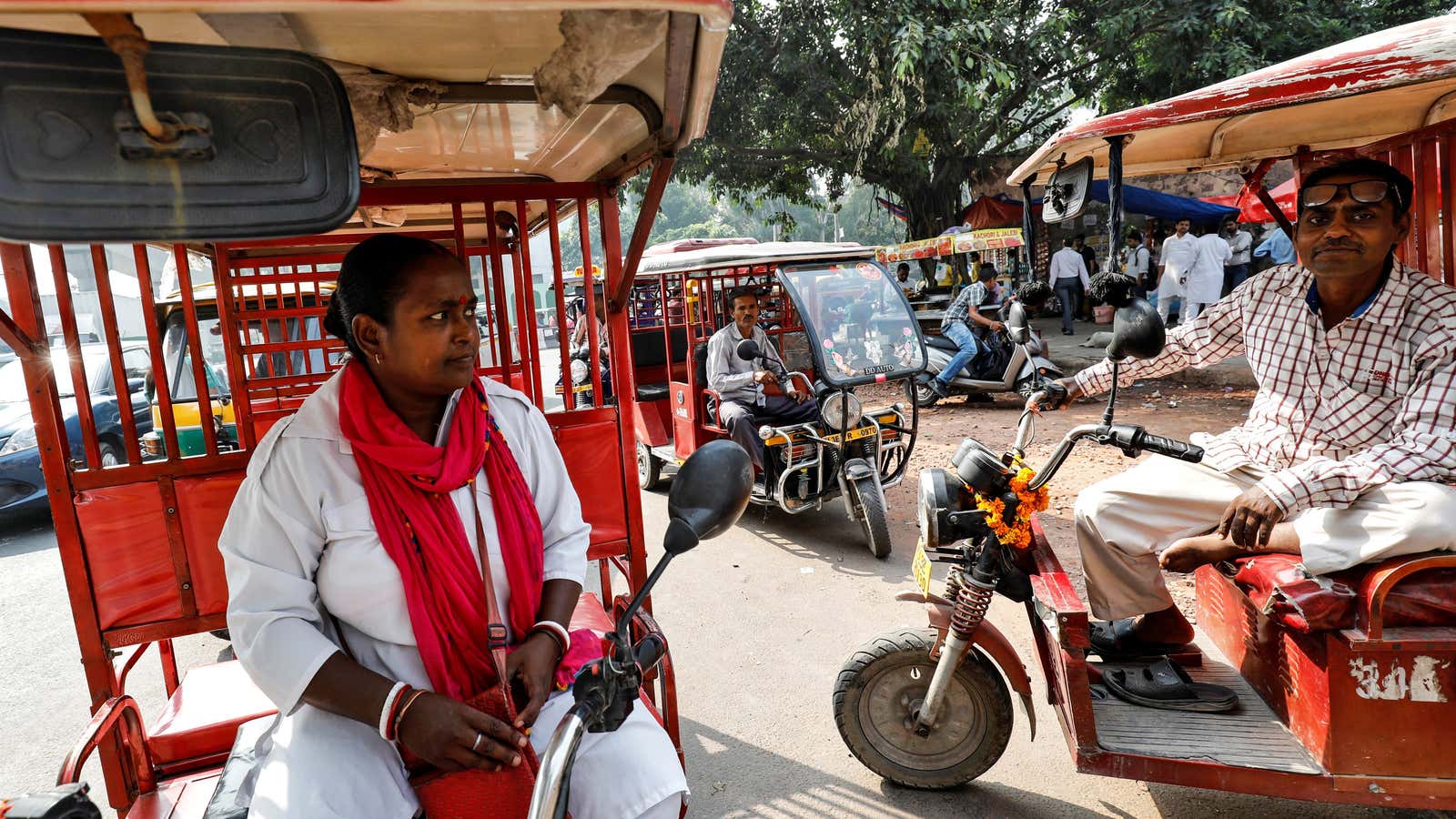The Indian government has set ambitious targets to accelerate the adoption of electric vehicles (EVs). By 2023, it wants all three-wheelers to run on batteries. By 2025, the rule will be applicable to most two-wheelers. Incentives are also being offered to make carmakers develop new EV models and manufacturing components such as lithium-ion batteries and electric motors.
Challenges, however, remain.
The most important, perhaps, is the need for strong policies. “India has a problem with policymaking, where someone can come up with a great idea and it will get lost in transition before it reaches the right person,” Arunabha Ghosh, CEO of Council on Energy, Environment and Water, a think tank.
Ghosh was speaking during a panel discussion at Chai & Chatter, an event organised by seed fund Blume Ventures in partnership with Quartz India on Sept. 5 in New Delhi. The panel was moderated by Quartz senior reporter Akshat Rathi and featured, besides Ghosh, Goldie Srivastava, co-founder and CEO of SmartE, a startup that runs India’s largest fleet of EVs, Saurav Kumar, founder and CEO of Euler Motors, a startup making commercial three-wheelers, Ayush Lohia, CEO of Lohia Auto, which also makes three-wheelers, and Priyank Agarwal, vice-president of strategy and business development at Exicom.

Lesson from China
Rathi: When the history of electric cars is written, the person who’ll stand taller is Wan Gang and not Elon Musk. Wan’s vision to make China an EV powerhouse revolutionised the global car industry. I am going to give you three numbers to explain why:
- Musk became the CEO in 2008 when Tesla was making less than 1,000 cars. Around the same time, Wan was made the minister of science in China. He’s an auto engineer who worked at Audi in Germany before he moved back to China. At the time, China was making less than 1,000 electric cars. Last year, Tesla struggled to make about 180,000 electric cars, China is now making 1.3 million electric cars.
- Tesla has raised about $6 billion in total. In the last decade, the Chinese government alone has invested $60 billion and about twice or thrice as much has come from private industry.
- Musk wants to electric cars to make the world a sustainable place. It’ll take a long time for Musk alone to do it. Just the use of electric buses in China has already cut its oil consumption by 300,000 barrels per day, which helps it to save $5 billion on oil imports each year.
Due to Wan’s efforts and strong government’s policies, China is now in the race with the West. The policies included both carrots, in the form of direct and indirect tax subsidies, and sticks in the form of limits in large cities on how many petrol or diesel cars could receive licences.
Today, in China if someone wants to own an EV, he can get it easily, the process is hassle-free. However, to buy a petrol car, it could take up to eight years. It’s the only middle-level income nation that features in the top countries pushing for the electrification of transport.
Policy problem
Ghosh: India does not know how to make a big bet on industrial policy. If we don’t fix that, India will have a haphazard transition to EVs, where the value creation that comes with both product and services will go outside the country.
Focus on financing should also be considered. Like in China, how the manufacturers get the subsidy from the government. And, of course, the charging infrastructure needs more push and if from a policy perspective we are able to do that then I think the startup ecosystem will boom.
Agarwal: If you go for a low indigenisation scenario, there’ll be pushback from existing automobile industry because there is value deduction since you are shutting down an existing industry. You will lose Rs5,000-6,000 crore. But in our estimation, by 2030, with high indigenisation you actually get additional industrial value of about Rs20,000 crore in the country.
So the EV transition will face major push from the traditional industry at the macroeconomic level, unless we make it a red line that we will not switch until we make the power trains and batteries in India. No other scenario will give a positive result.
Lohia: In countries like the US, China and Europe, you don’t have to deal with the problem of potholes, water-logging on the roads, and you don’t find dust. In India, we need to deal with these things first. If you think of using a European or even Chinese EV in India, you’ll be wasting your time, money, and energy.
Battery supply situation
Agarwal: A lot of knowledge is needed in developing battery packs. So unless you know what you are doing with imported cells, even after an exhausting procedure, you may end up with really bad quality. In our case, we have a team of highly skilled local professionals who have worked with companies across the globe.
Battery swapping
Srivastava: The main advantage of battery swapping is that it reduces the wait time by around 60% while the cost rises by around 50%. Does that make economic sense? In Delhi itself, there are places where it works smoothly and then there are places it will not work at all.
Agarwal: I was the biggest sceptic of battery swapping until last year. Now I have changed my view. As long as a vehicle’s uptime can be increased in terms of its commercial usefulness, it makes sense. Otherwise it doesn’t, owing to the huge costs involved. Our company has observed that drivers of commercial three-wheelers are able to increase their on-road time by 30% to 40% and it takes them a couple of minutes to swap, so it works. In the case of four-wheelers due to the heavy weight of the battery, it is difficult to swap. However, commercial two-wheelers and three-wheelers can able to swap very easily.
Challenge of charging infra
Srivastava: There is no other way to have charging infrastructure than to build your own. Our company realised it and we built it for us. If you rely on the government, then you are doomed.
Honestly, creating charging infrastructure is not a costly affair. The real problem is can the grid support the rising load of charging stations? If you take just the Delhi government’s target, by 2023, there will need to be 2500 new EVs every single day on the city’s roads. Even if these are low power vehicles, we are still talking about commissioning 4 MW of power dedicatedly just for EV charging. So, for me, setting up the hardware is easier but if the grid collapses tomorrow what will happen then?
Where’s the skilled labour?
Lohia: There’s a huge gap between understanding of the product and how things actually happen on the ground. If you want to find a person who has knowledge of what’s happening with the background of electrical and mechanical both combined, you will hardly find the skilled people. We need to address this knowledge gap. In India, we don’t have much awareness about product development and challenges it will face on the roads.
Ghosh: Recently, I was teaching at IIT Madras. The general sense among the students there is that they trained themselves for the wrong sector. Today, even the traditional auto industry demands labour skilled in the software developing, which for the EV industry is a must. So the question isn’t what do we need to provide extra on-job training, but are we providing enough education to start with.
Care for the climate?
Ghosh: The emissions from the transport sector in India are very small, unlike in the US or Europe. In India, power sector decarbonisation is already happening, and industrial decarbonisation will be the next task. There sectors contribute between 20% and 35% of national emissions. The share of the transport sector is less than 10%. Therefore, in India’s case, the climate change hook does not matter as much for the EV transition.
